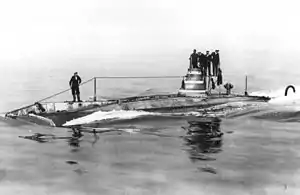HMS A3
HMS A3 was an A-class submarine built for the Royal Navy in the first decade of the 20th century. She sank in 1912. The wreck is a Protected Wreck managed by Historic England.
 HMS A3 | |
| History | |
|---|---|
| Name | HMS A3 |
| Builder | Vickers, Sons & Maxim, Barrow-in-Furness |
| Yard number | 295 |
| Laid down | 6 November 1902 |
| Launched | 9 May 1903 |
| Commissioned | 13 July 1904 |
| Fate |
|
| General characteristics | |
| Class and type | A-class submarine |
| Displacement |
|
| Length | 105 ft (32.0 m) |
| Beam | 12 ft 9 in (3.9 m) |
| Draught | 10 ft 8 in (3.3 m) |
| Installed power |
|
| Propulsion |
|
| Speed |
|
| Range | 320 nautical miles (590 km; 370 mi) at 10 kn (19 km/h; 12 mph) surfaced |
| Complement | 2 officers and 9 ratings |
| Armament | 2 × 18-inch (45 cm) torpedo tubes |
Design and description
A3 was a member of the first British class of submarines, although slightly larger, faster and more heavily armed than the lead ship, HMS A1. The submarine had a length of 105 feet 1 inch (32.0 m) overall, a beam of 12 feet 9 inches (3.9 m) and a mean draft of 10 feet 8 inches (3.3 m). They displaced 190 long tons (190 t) on the surface and 206 long tons (209 t) submerged. The A-class submarines had a crew of 2 officers and 9 ratings.[1]
For surface running, the boats were powered by a single 16-cylinder 450-brake-horsepower (336 kW) Wolseley petrol engine that drove one propeller shaft. When submerged the propeller was driven by a 150-horsepower (112 kW) electric motor. They could reach 10 knots (19 km/h; 12 mph) on the surface and 7 knots (13 km/h; 8.1 mph) underwater. On the surface, A3 had a range of 320 nautical miles (590 km; 370 mi) at 10 knots (19 km/h; 12 mph);[1] the boat had a range of 30 nautical miles (56 km; 35 mi) at 5 knots (9.3 km/h; 5.8 mph) submerged.[2]
The boats were armed with two 18-inch (45 cm) torpedo tubes in the bow. They could carry a pair of reload torpedoes, but generally did not as doing so that they had to compensate for their weight by an equivalent weight of fuel.[3]
Construction and career

A3 was laid down by Vickers, Sons & Maxim as Yard No.295 at Barrow-in-Furness on 6 November 1902 and was launched on 9 May 1903.[4][5] She was commissioned on 13 July 1904.[4] She primarily served as a coastal defense and training submarine in her over seven years of service.
On 2 February 1912, A3, along with several other submarines dispatched from the port of Gosport, conducted training exercises on target ships in the Solent.[6] Whilst attacking the depot ship HMS Hazard, the semi-submerged A3 accidentally collided with its target 2 nautical miles (3.7 km; 2.3 mi) southwest of the East Princessa Buoy in the eastern Solent.[7] Its rudder and propeller were both disabled, and the holed submarine sank immediately with all 14 hands lost.[6] The King sent his immediate condolences to the families of the lost seamen.[7]
The submarine was raised from the bottom on 11 March and was brought into the south lock of Portsmouth dockyard the following day, slung below a salvage lighter; the lock was pumped dry so that the 14 bodies could be recovered and the damages surveyed.[8]
After being towed from Portsmouth to Portland Naval Dockyard, the wreck was towed offshore into Weymouth Bay and, after some technical experiments on the hull, it was sunk as a gunnery target by shells from HMS St. Vincent on 17 May 1912.[9][10] In July 2016 the wreck of A3 was officially designated as a protected site.[11]
Notes
- Gardiner & Gray 1985, p. 86.
- Akermann 2002, p. 120.
- Harrison, chapter 27
- "A-3". Shipping and Shipbuilding. Shipping and Shipbuilding Research Trust. Archived from the original on 22 April 2022. Retrieved 22 April 2022.
- "Launch of a Submarine". The Westminster Gazette. No. 3154. 11 May 1903. p. 7. Retrieved 22 April 2022 – via British Newspaper Archive.
- McCartney 2002, p. 77.
- "Submarine goes down, in collision with HMS Hazard". The Daily News. No. 20, 562. London. 3 February 1912. p. 1. Retrieved 22 April 2022 – via British Newspaper Archive.
- "Salving the A3: Arrival at Portsmouth". The Evening News. No. Vol XXXVII, 10, 771. Portsmouth. 12 March 1912. p. 8. Retrieved 22 April 2022 – via British Newspaper Archive.
- McCartney 2002, p. 78.
- "Last of the A3: sunk by battleship's guns". The Evening News. No. Vol XXXVII, 10, 826. Portsmouth. 18 May 1912. p. 5. Retrieved 22 April 2022.
- "British A3 submarine sunk off Jurassic Coast in 1912 gets protected status". Dorset Echo. Newsquest Media. 22 July 2016. Retrieved 24 July 2016.
References
- Akermann, Paul (2002). Encyclopaedia of British Submarines 1901–1955 (reprint of the 1989 ed.). Penzance, Cornwall: Periscope Publishing. ISBN 1-904381-05-7.
- Colledge, J. J.; Warlow, Ben (2006) [1969]. Ships of the Royal Navy: The Complete Record of all Fighting Ships of the Royal Navy (Rev. ed.). London: Chatham Publishing. ISBN 978-1-86176-281-8.
- Gardiner, Robert & Gray, Randal, eds. (1985). Conway's All the World's Fighting Ships 1906–1921. Annapolis, Maryland: Naval Institute Press. ISBN 0-85177-245-5.
- Harrison, A. N. (1979). The Development of HM Submarines From Holland No. 1 (1901) to Porpoise (1930). London: Ministry of Defence. Archived from the original on 19 January 2022. Retrieved 28 September 2022 – via RNSubs/Barrow Submariners Association.
- McCartney, Innes (2002). Lost Patrols: Submarine Wrecks of the English Channel. Periscope Publishing Ltd. ISBN 1-904381-04-9.
- Gray, Edwyn (2003). Disasters of the Deep A Comprehensive Survey of Submarine Accidents & Disasters. Leo Cooper. ISBN 0-85052-987-5.